Last week, after three amazing years, I finally graduated from the University of Winchester with a 2:1 in English Literature and History. Graduation was an unforgettable experience, spent catching up with friends, trying not to trip, and posing for about a thousand awkward photographs that will, presumably, stare down at me from my grandfather’s display cabinet until the end of time.


It was also, as I’m sure every Winchester grad can confirm, spent looking around in absolute awe at the beautiful cathedral we’re so lucky to graduate in. What a building! And what a history! As I stood nervously, waiting for my name to be called and wobbling in my heels (in hindsight, a poor choice on the uneven stone floor), I couldn’t help but think of all the sights the cathedral must have seen over the years and of all the other people to have passed through those impressive wooden doors.
I knew various tidbits about the cathedral’s history- such as the gloriously higgledy-piggledy stained glass in the West Window, which had been swept up and restored by the people of Winchester after Cromwell’s men destroyed it during the Civil War- but I suddenly felt inspired to learn more. More than that though, I wanted to jot down some highlights here, hopefully to inspire others to visit (and to fall in love with) Winchester Cathedral.
But first:
(Because what post about Winchester Cathedral would be complete without this gem from the ‘60s?)
Anglo Saxon Origins
Now, Winchester Cathedral has its roots in the seventh century, when the pagan monarchs of England first converted to Christianity. In 635, Cynegils, king of the West Saxons, was baptised and, just over a decade later, his son Cenwalh built the first Christian church in Winchester, which was by then the heart of Anglo Saxon Wessex.
This was a small, cross-shaped church which became known as Old Minster. In these blurry photos I took back in 2014 on my freshers’ tour of the cathedral, you can just about make out where it stood, slightly to the north of the present building and outlined in red brick.
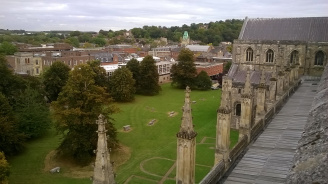
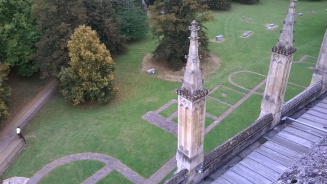
Soon, Old Minster became a cathedral, housing the cathedra of a bishop responsible for a huge diocese that stretched all the way from the English Channel right up to the River Thames. In turn, it became the most important church in Anglo Saxon England, and was the burial place for many of the earliest kings of Wessex, including King Alfred the Great. The legendary King Cnut is also buried at Winchester alongside his wife, Queen Emma.
A Place of Pilgrimage
By the tenth century, Old Minster had become the priory church of a community of monks, living under the care of St Benedict. The church was made even bigger and grander by Bishop Aethelwold, who had the bones of St Swithun moved from their burial place in the forecourt, and housed in a new shrine inside. The fame of St Swithun and his miracles spread far and wide and all around his tomb, the walls were hung with the crutches of people he was said to have healed.
By the year 1000, Old Minster was a multipurpose building- having become a mighty cathedral in its own right, a thriving priory church, and a renowned place of pilgrimage.
E-norman-ous Change
Significant changes were to lie ahead for Winchester however, as England’s Saxon leaders were abruptly toppled following the events of 1066 and the invasion of William the Conqueror. He was anointed king on Christmas Day at a ceremony in Westminster Abbey, and quickly moved to take control of the Church.
Winchester’s last Saxon bishop was replaced with his own royal chaplain, Walkelin, and the French bishop soon set about building a huge new church in the Norman Romanesque style. After 450 years, Old Minster was demolished. Its stones were used for the new cathedral, consecrated in 1093 with a grand ceremony attended by almost all of England’s bishops and abbots.
Medieval Majesty
The Norman cathedral soon flourished. In 1100, William the Conqueror’s son, William Rufus (the Red), was buried here following his suspicious death whilst out hunting in the New Forest. He was buried under the tower of his father’s great cathedral, which collapsed seven years later- according to local folklore, as a result of his wickedness.
Around this time, sumptuous works of art were being commissioned. A glorious new font was installed, celebrating the life of St Nicholas and later, in the twelfth century, a magnificent illuminated Bible was made for the monks to use in their daily worship. The Winchester Bible can still, to this day, be seen in the Cathedral Library.
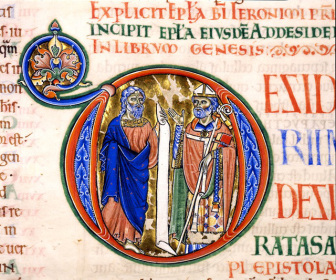 Extract from The Winchester Bible
Extract from The Winchester Bible 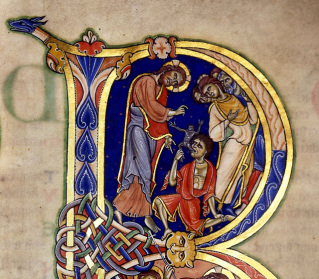 Extract from The Winchester Bible
Extract from The Winchester Bible
In the centuries that followed, wealth and powerful bishops would put their stamp on the Norman cathedral. It was re-modelled again and again, with soaring gothic arches added in the fourteenth century and made more ornate in the fifteenth and sixteenth centuries. They also commissioned their own chantry chapels, where priests would say daily masses over their tombs to speed their souls into Heaven.
Reformation Transformation
The dissolution of the monasteries, following the Act of Supremacy and Break with Rome in 1534, lead to many changes and upheavals for the cathedral. After nearly 600 years, Winchester’s great Benedictine monastery, St Swithun’s Priory, had come to an end. The shrine of its patron saint was ransacked under the cover over darkness and its cloister demolished.
Catholicism was briefly revived in the 1550s by Mary Tudor, who married King Philip II of Spain at a ceremony held in the cathedral, but it was not to last long. Since the reign of Elizabeth I (1558-1603), the cathedral has been Church of England.
From Pride and Prejudice to the Present Day
By the early sixteenth century, much of the Cathedral as it appears today was complete. New secular names became forever linked to it, in addition to those of many kings and bishops. In the seventeenth century, the angler Izaak Walton was buried in Winchester Cathedral, as was the great novelist Jane Austen, back in 1817.
All was nearly lost in the early 1900s however, as concerns began to grow that the east end of the building would collapse following centuries of subsidence. Miraculously though, the deep-sea diver turned hero, William Walker, worked for six solid years (in terrible conditions, underwater and in complete darkness) and was able to stabilise and, ultimately, save the cathedral!
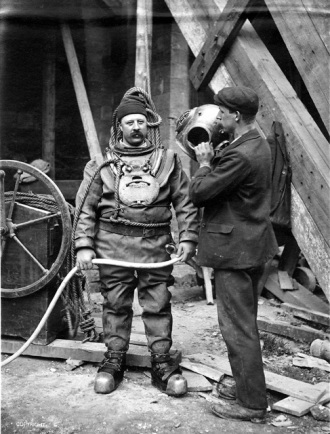 William Walker saves the cathedral
William Walker saves the cathedral 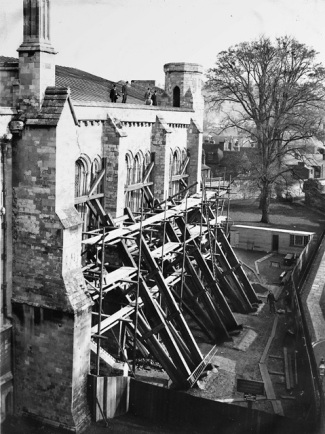
In 2017, after twelve centuries, the beautiful cathedral remains the seat of the Bishop of Winchester and centre of the Diocese of Winchester. It continues to echo with the sounds of sacred music, daily prayer and, on occasion, the voice of Alan Titchmarsh (Chancellor of the University of Winchester) congratulating graduates.
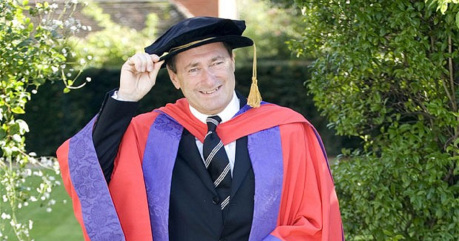
It truly is an incredible place to visit, and I would fully encourage everyone to do so.
[Originally posted here on the 29.10.17]
Advertisements Share this:





